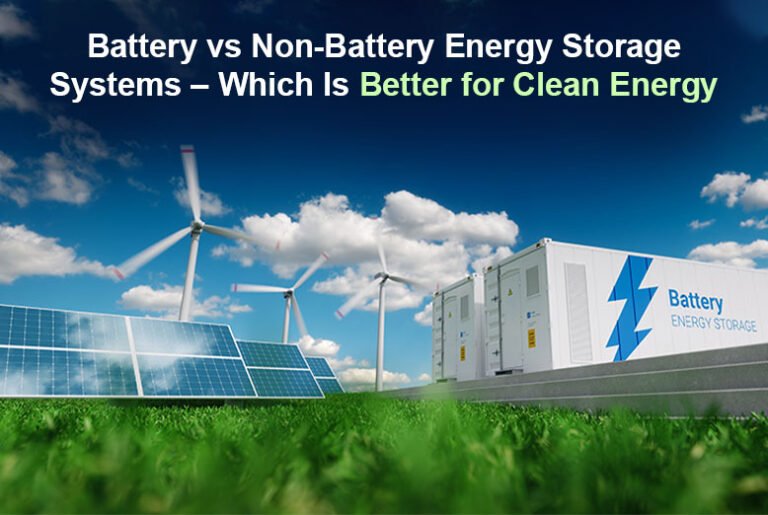Clean energy doesn’t just begin and end with generating solar or wind power. The real test is how well we can store that energy and use it when it’s actually needed. Energy storage systems are quietly becoming one of the most important parts of the renewable energy conversation. However, nowadays, you have a choice of storage systems – battery and non-battery systems.
If you’re trying to understand how clean energy can truly work around the clock, a comparison might help you see which option makes more sense, depending on how the energy is being used.
How Battery Storage Systems Fit Into Clean Energy?
Battery-based energy storage systems use chemical reactions to store and release electricity. Lithium-ion batteries are the most commonly used type. Flow batteries and newer solid-state designs are slowly making their way into real-world applications. For smaller home or backup applications, a sealed battery can be an ideal choice, offering safety and ease of use without the need for regular maintenance.
Batteries are fast, compact, and can be placed anywhere. They’re great for storing excess solar energy during the day and using it after the sun sets.
That said, batteries wear down over time, especially if they’re used heavily. While batteries are getting more affordable, they still need a bit of an upfront investment.
The Role of Non-Battery Storage Solutions
Now, let’s look at storage systems that don’t rely on batteries. These are quite different in how they work. Some store energy by moving things, like water, being pumped to a higher place and then released to create electricity later. Others store energy as heat or compressed air.
Non-battery systems tend to be used where large amounts of energy need to be stored for longer periods. They’re less about speed and more about endurance.
They usually don’t involve chemicals, which means they avoid the environmental issues that come with batteries. But they often need more space and infrastructure to work. They’re built where there’s enough room and where the surroundings allow for it.
When Battery Storage Makes Sense
If you’re someone who wants more control over your home’s power supply, battery storage might be what you look at first. Batteries work best when the energy needs are short-term or moderate. They respond quickly and can be managed easily with smart systems.
Once set up, it works in the background without needing a lot of attention. You can store solar energy, use it when the grid is down, or just during the evening.
When Non-Battery Storage Has The Upper Hand
If we’re talking about projects that need to store a lot of energy and use it slowly over a long period, non-battery systems are usually useful. These setups may take more time and effort to build, but they tend to last longer and operate consistently without the wear and tear that batteries go through.
They also make sense in areas where energy demand is steady and predictable, like rural communities or industrial zones that want a more stable supply.
What Works Best Depends On The Situation
The question of whether battery or non-battery systems are better doesn’t really have one right answer. It depends entirely on the setting.
If you’re living in a city where space is limited and your energy use varies a lot during the day, a battery system makes more sense. It’s quick, flexible, and easier to integrate into a small space.
On the other hand, if you’re dealing with a larger, more constant demand for power, like in a remote area or for a facility that runs 24/7, a non-battery system could offer more consistency and lower maintenance over time.
In some cases, it’s not even about choosing one over the other. More and more, hybrid systems are being built that combine the strengths of both. These setups can use battery systems to handle quick, short-term needs and rely on non-battery storage to manage longer demands. This kind of balance helps create a cleaner and more dependable energy supply across different situations.
Clean energy doesn’t work in isolation. It’s not just about generating power from the sun or wind. It’s about managing that energy in a way that makes it usable whenever and wherever it’s needed. And that’s why storage is such an important part of the picture.
Storage and India’s Clean Energy Future
India has set high goals for renewable energy, and it’s already made strong progress. But generation alone won’t get the country where it needs to be. The bigger challenge now is making sure clean energy is available consistently, especially during times when the source itself isn’t active, like after sunset or when the wind slows down.
This is where energy storage systems step in, not just as support tools but also as key components in the clean energy journey. They help balance out the fluctuations, reduce waste, and create a smoother power flow to homes, businesses, and communities. Whether the system is battery-based or uses other methods, it’s the ability to store energy effectively that will decide how far clean power can go.
Developers like Hero Future Energies understand that storage isn’t a one-size-fits-all problem. Their projects are already exploring and implementing solutions that make storage more adaptable, whether that’s through advanced battery systems or mechanical innovations.
Conclusion
If you’re someone who cares about clean energy, not just as a concept but as something that impacts daily life, it helps to know that storage is where a lot of the innovation is happening. Knowing the difference between battery and non-battery systems gives you a clearer view of how this clean energy future is being built.
Also Read: Top 5 Green Energy Penny Stocks in India [Updated 2025]



